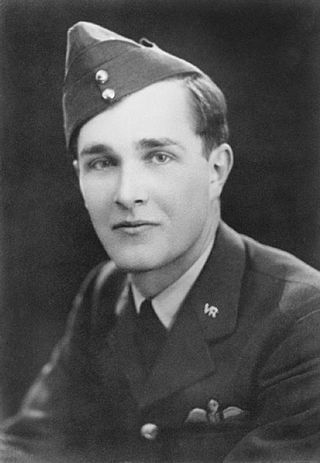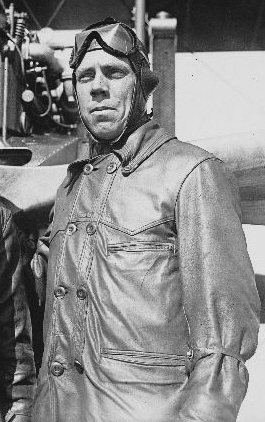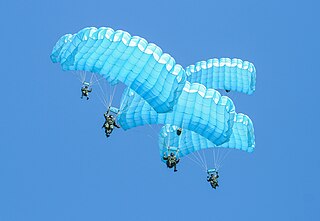
A parachute is a device used to slow the motion of an object through an atmosphere by creating drag or, in a ram-air parachute, aerodynamic lift. A major application is to support people, for recreation or as a safety device for aviators, who can exit from an aircraft at height and descend safely to earth.

The Military Freefall Parachutist Badge is a military badge of the United States Army and United States Air Force awarded to qualified U.S. Army and U.S. Air Force personnel as high-altitude military parachute specialists.

Leslie Thomas Manser, VC was a British bomber pilot and a recipient of the Victoria Cross, which was awarded posthumously following an attack on the German city of Cologne.

The Parachutist Badge, also commonly referred to as "Jump Wings", is a military badge of the United States Armed Forces. Some services, such as the Marine Corps, officially refer to it as an insignia instead of a badge. The United States Space Force and United States Coast Guard are the only branches that do not award the Parachutist Badge, but their members are authorized to receive the Parachutist Badges of other services in accordance with their prescribed requirements. The DoD military services are all awarded the same Military Parachutist Badge. The U.S. Army and U.S. Air Force issue the same Senior and Master Parachutist Badges while the U.S. Navy and U.S. Marine Corps issue the Navy and Marine Corps Parachutist Insignia to advanced parachutists. The majority of the services earn their Military Parachutist Badge through the U.S. Army Airborne School.

The United States Army Airborne School—widely known as Jump School—conducts the basic paratrooper training for the United States Armed Forces. It is operated by the 1st Battalion (Airborne), 507th Infantry, United States Army Infantry School, Fort Moore, Georgia. The Airborne School conducts the Basic Airborne Course, which is open to troops from all branches of the United States Department of Defense, Reserve Officer Training Corps, and allied military personnel.

Leslie Leroy Irvin was a stunt-man for the fledgling Californian film industry. Flying in balloons, he performed using trapeze acrobatics and parachute descents. For the 1914 film Sky High, Irvin made his first jump out of an airplane while flying at 1,000 feet above the ground. In 1918, he developed his own life-saving static line parachute, jumping with it several times and promoting it to the US Army. Irvin joined the Army Air Service's parachute research team at McCook Field near Dayton, Ohio where he made the first premeditated free-fall jump with the modern parachute on April 28, 1919.
George Herman Bennions, DFC, nicknamed "Ben", was a British flying ace who served with the Royal Air Force (RAF) during the Second World War. He was credited with having shot down at least twelve aircraft.

James Floyd Smith was an inventor, aviation pioneer, and parachute manufacturer. With borrowed money, he built, then taught himself to fly his own airplane.

IrvinGQ, formerly known as Airborne Systems, is an aerospace manufacturing company based in Llangeinor, Wales, United Kingdom. It specialises in the design, manufacture and supply of a range of parachutes and emergency, rescue and survival equipment for both the military and civilian markets.

Skydive Hibaldstow is a parachuting and skydiving drop zone centre in Hibaldstow, North Lincolnshire, England. Skydive Hibaldstow is affiliated with the skydiving company British Skydiving.

Flight Lieutenant John Alan Quinton, GC, DFC was a British navigator and pilot who was posthumously awarded the George Cross for an act of outstanding bravery where he unselfishly saved a young air cadet whilst losing his own life after the aircraft he was in was involved in a mid-air collision over Yorkshire.

The Goldfish Club is a worldwide association of people who have escaped an aircraft by parachuting into the water, or whose aircraft crashed in the water, and whose lives were saved by a life jacket, inflatable dinghy, or similar device. The Goldfish Club badge shows a white-winged goldfish flying over two symbolic blue waves. The main aim of the club is 'to keep alive the spirit of comradeship arising from the mutual experience of members surviving, "coming down in the drink".'

Parachuting and skydiving is a method of transiting from a high point in an atmosphere to the ground or ocean surface with the aid of gravity, involving the control of speed during the descent using a parachute or parachutes.

The British Armed Forces award a range of Parachutist Badges to those qualified as military parachutists. The version awarded depends largely on the unit or role that the individual fills following qualification.

Squadron Leader Robin John McNair, DFC and Bar was a prominent Royal Air Force fighter pilot during the Second World War. After the war he enjoyed a long and successful career in civil aviation as a senior figure in BEA, later to become British Airways.
Attacks on parachutists, as defined by the law of war, occur when pilots, aircrew, and passengers are attacked while descending by parachute from disabled aircraft during wartime. Such parachutists are considered hors de combat and it is made a war crime to attack them in an interstate armed conflict under Additional Protocol I to the 1949 Geneva Conventions. However, firing on airborne forces who are descending by parachute is not prohibited.

A parachute tower is a tower used for parachute training, often by members of a military paratroop unit. A mixture of tower heights are used at different stages of training. Trainees typically begin on towers around 35 feet (11 m) in height in fall-arrest harnesses before progressing onto parachute descents from towers that can be in excess of 250 feet (76 m). The use of towers allows trainees to practice their landing technique before jumping from an aircraft.
Odette Rousseau was a French parachutist. She qualified at the age of 23 and became French national champion in 1953 and a world champion in 1954. Rousseau made a world record jump on 25 August 1955 from a height of 8,721 metres. She later attended many Fédération Aéronautique Internationale committees and was appointed an officer of the Legion of Honour.

Edward Lincoln Hoffman (1884–1970) was a United States Army Air Service (USAAS) pilot, officer and Engineering Division Chief at McCook Field. With no parachute experience, he formed a team that included aviation pioneers Leslie Irvin and James Floyd Smith which developed the first modern parachute. The 1926 Collier Trophy was awarded to Major E. L. Hoffman, Air Corps for "development of a practical parachute;" the year's greatest achievement in American aviation.
Archibald “Archie” Pell Atherton III was an American pioneering parachutist, and inventor of various patented parachute designs. A pioneer for air safety; he is known as the originator of "spot landing", averaging a drop a day for one year at his peak.

















